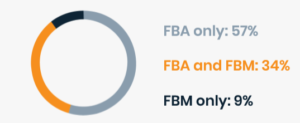In the Amazon-selling world, the FBA (Fulfillment by Amazon) vs. FBM (Fulfillment by Merchant) debate is ongoing. But really, how do you know which is right for you? The answer is not as simple as one or the other, sometimes it’s “both.” Many sellers have already figured that out – and you should, too.
Win With the eTail Giant
The number of active sellers on Amazon is nearing 2 million1. That’s not a huge surprise given the number of Amazon vans driving around on a daily basis. What’s interesting is the breakdown in how these retailers are selling:

FBM (Fulfillment by Merchant)
FBM, or Fulfillment by Merchant, is the less popular of the two programs. FMB allows sellers to publish their products on Amazon, but still maintain control over storing inventory and shipping orders. These sellers can choose to store inventory themselves, in their own warehouses, or in a 3rd party (3PL) fulfillment center.
FBM PROS
- Less Amazon Fees – Companies who have a robust logistics network to fulfill orders can save on Amazon fees like stocking, removals, return processing, long-term storage, and more by storing and shipping through their own fulfillment centers.
- Inventory Control – Sellers have more control over distribution, inventory stocking and availability. Having your own warehouse allows you to sell products on platforms other than Amazon (Walmart, Newegg, Wayfair, etc). You can also manage your inventory across all platforms without having to use Amazon’s MCF (multi-channel fulfillment) program.
- Increased Availability – A big attraction for FMB is the fact that sellers do not have to compete for Amazon warehouse inventory space. This is especially important during busy seasons. By managing inventory yourself, you can maximize efficiencies during the check-in/out process – and actually take advantage of peak season.
FBM CONS
- Buy Box Implications The most significant drawback to FBM is decreased chances of winning the Buy Box. FBA fulfillment normally includes Amazon Prime qualification, which significantly improves product visibility and increases sales. If a seller is FBM, they should consider eligibility for the Amazon SFP (Seller Fulfilled Prime) program in order to remain competitive against FBA sellers.
- Lower Amazon SEO Sellers switching from FBA to FBM or FBM/SFP will likely experience a slight drop in rankings for their products. A lower ranking could result in a decrease in sales.
FBA (Fulfillment by Amazon)
The front-runner in the Amazon-selling world is FBA, or Fulfillment by Amazon. In this program, sellers send inventory directly to Amazon warehouses and Amazon automatically fulfills orders on their behalf
FBA PROS
- Quick Set-Up – If you’re just getting started, FBA selling is a quick and relatively pain-free way to launch your ecommerce business. Sellers ship products to Amazon and they handle the rest.
- Easy Maintenance – Because Amazon manages the infrastructure, staffing, and all things related to storing and shipping your product, you can focus your energy and time to other areas of your business.
- Prime Eligibility – 80 million buyers subscribe to the Amazon Prime program, making FBA an attractive avenue for many sellers. You’ll likely sell more with Amazon Prime and capitalize on profits.
FBA CONS
- Lack of Control – While relinquishing control can be good, it also has its drawbacks. There are certain things you agree to as an FBA seller, like following stringent packaging requirements that are non-negotiable. Failure to comply could result in your product not getting shipped at all.
- Decreased Visibility – Especially during peak season, visibility into the products you have, and the handling of them, can be a challenge. Errors happen with the volume of product Amazon is moving on a daily basis.
- Additional Fees – Amazon doesn’t work for free and having them store and ship your product comes with a price tag. Heavy or bulky items in particular cost more and reduce profits. It’s also important to understand your tax obligations that come as an FBA seller.
A Balancing Act : With a balance of FBA and FBM, you get the biggest bang for your buck.
- Use FBA for high-volume items – Amazon has the infrastructure and expertise to manage packing and shipping on a daily basis, making it worth the extra fees.
- During peak season, don’t leave FBM behind Amazon isn’t going to prioritize stocking your product specifically during high-volume months. Ensure you have items listed for FBM to keep sales steady.
- Small and light = FBA It’s easier and cheaper for Amazon to store and ship items that are small and light. You won’t see as much of an impact to your bottom line for these products.
- Bulky and heavy = FBM The opposite is true for bulky and heavy products. It’s likely going to make more sense for you to ship these yourself and not incur the fees associated with them.
Maximize Profits With FBA and FBM
Amazon FBA Audit – If you choose to sell FBA, there are many tools that can help you keep more of your money. With Sifted Amazon Audit, you get automatic tracking and refunds for warehouse mistakes that Amazon makes. Some common refundable errors include inbound and lost and damaged shipments, FBA fees, and customer returns. If you do choose FBA, you should have assurance that your product is being properly audited and accounted for. Sign up for free.
FBM Logistics Intelligence – When you are handling shipping on your own, it’s important to understand how things like box size and service-type can impact your bottom line. A data-science software like Sifted Logistics Intelligence can give you those answers. You can even plan for achieving 2-day prime standards if you are, or want to be a part of, the Amazon’s Seller Fulfilled Prime program. Get a free demo to learn more.
To download this article as an attachment, click here.
Article Submitted By:
Leilani Gastelum, Product Owner, Sifted



Recent Comments